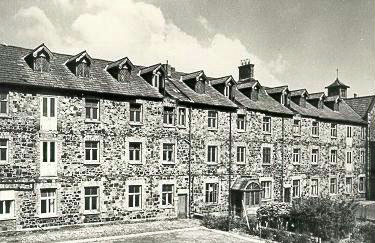 On 12 February 2014 Dr. Georgina Laragy gave a talk to members of Bangor Historical Society on the workhouse in nineteenth century Ulster. She is one of five people at Queen’s University researching the period 1800 to 1973 with particular reference to the plight of the poor in Belfast.
On 12 February 2014 Dr. Georgina Laragy gave a talk to members of Bangor Historical Society on the workhouse in nineteenth century Ulster. She is one of five people at Queen’s University researching the period 1800 to 1973 with particular reference to the plight of the poor in Belfast.
Dr. Laragy began by explaining that the workhouse system lasted in Ulster from the 1830s to the late 1940s when fear of the workhouse persisted because it meant poverty and a loss of respectability.
Measures to help the poor had been undertaken in various places during the eighteenth century. In Belfast Clifton House was set up and financed by a tax on local households and later by a local lottery. These measures were usually limited to individual cities.
In early nineteenth century Ireland there was great poverty, especially in the countryside. The population had risen to about 8 million in 1841. There was thus an obvious need for a nationwide system. The Irish poor Law was introduced in 1838, modelled upon the 1834 English Poor Law. The poor were classified as deserving and underserving and this affected how they were treated.
Ireland was divided into poor law unions each with its own workhouse. Initially there were 130. The unions in County Down included those at Downpatrick, Newry and for the north of the county, Newtownards. The system was financed by a tax on land. Each union had a Board of Guardians which appointed a master to run the workhouse. By the 1870s local people such as butchers and builders were running for election to the Board of Guardians as they realised the importance of the union as a source of contracts. Women were first allowed to stand for election as guardians in the 1890s.
The workhouses were built to a standard plan with separate accommodation for different categories of people such as the old, boys, girls, men and women. There was also an infirmary and exercise yards. Thus when a family entered the workhouse they were split up.
The able-bodied men were expected to do work such as breaking stones and picking oakum, while women worked in the laundry. Diet included items such as meal and buttermilk. In the early years of the workhouse the majority of inmates in County Down were children. By the 1850s there was a strong feeling that the workhouse was not an appropriate place for children and instead they were boarded out with families. Outdoor relief, ie help for the poor in their own homes, was not originally given, but became necessary for a time during the famine.
Ian Wilson proposed the vote of thanks to the speaker for an interesting and informative talk.
